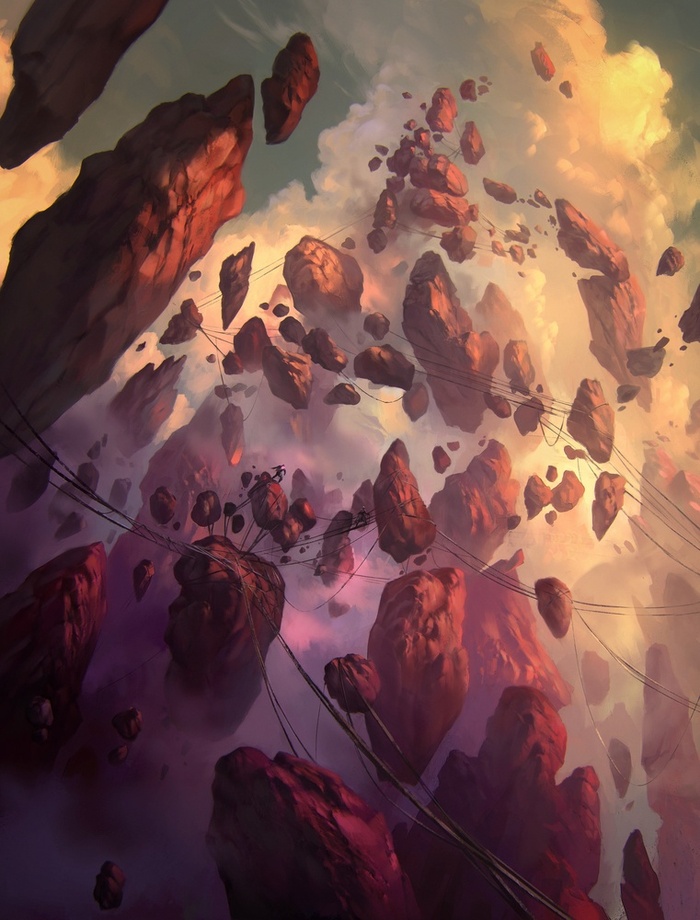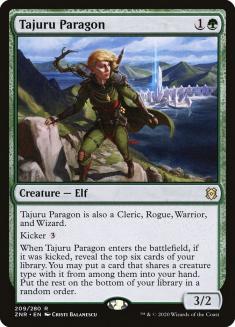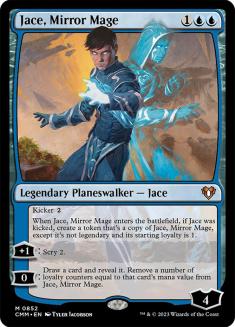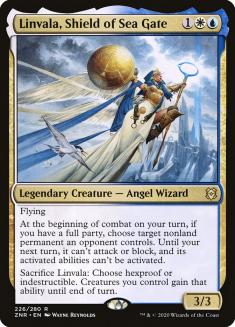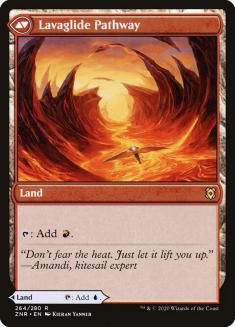Welcome to another edition of Fact or Fiction! Today, Michael Majors. Ari Lax, and Paulo Vitor Damo da Rosa are here to give their takes on five statements about Zendikar Rising. Don’t forget to vote for the winner at the end!
1. You’re excited about the return of the kicker mechanic.
Michael Majors: Of course. Kicker is incredible because modality is really fun. It’s why folks love Charms and Commands so much; players want agency and kicker can grant that in a variety of interesting ways. Seeing Jace, Mirror Mage originally in the file internally as a planeswalker with kicker was just so cool.
From a gameplay perspective, kicker makes a ton of sense on Zendikar. Zendikar’s themes have always been about lands, and more natural incentives to put more lands in your deck, like kicker, naturally improve the gameplay experience.
Ari Lax: Fact. Kicker is the vanilla ice cream of mechanics. It’s not exciting because cookie dough or basically anything else is vanilla with a twist, but that’s because vanilla is so good and so easy to riff on that it’s become the default.
I just freaking like ice cream, and Wizards of the Coast (WotC) knows how to make a good vanilla kicker set. And if Magic Arena is telling me to draft to own cards, I am down to just shovel a ton of vanilla ice cream format into my digital Magic mouth.
To smash through the metaphor, feel free to hit me up on Twitter to discuss actual ice cream. Owning an ice cream maker has been a huge win over the last months of isolation from professional ice cream shops and I’m down to hear and share flavor ideas.
Paulo Vitor Damo da Rosa: Fact. I love kicker. It’s one of my favorite mechanics. I think it’s so great because it’s very simple but at the same time very skill-rewarding, which means it benefits you for playing well without making the game too complicated. I remember way back when that one of the most skill testing things in the game was knowing when to cast your Kavu Titan as a 2/2 and when to wait for the superior 5/5, and you could really tell who the best players were by watching when they would bite the bullet on it.
I also like it because the design possibilities are virtually endless. You can have all sorts of different effects with kicker, so it’s a mechanic that we can revisit as many times as we want without feeling like we’re going back to the same things.
2. The party mechanic will be Constructed-playable.
Michael Majors: N/A. I’m not at liberty to discuss this….
All jokes aside, WotC naturally wants its cool new mechanics to show up in Constructed. Developing party cards was really tricky and a lot of the discussion was placed on how to price cards at the correct levels to make sure there wasn’t too large a delta between having a single party member and a full party. Generally, it’s pretty difficult to expect players to have more than two party members on the battlefield, but you also have to balance how difficult it is to get paid for having a full party with too significant a return on rate. So, to answer the question, it was challenging, and there are a lot natural barriers for a “go-wide” mechanic to succeed, but I have faith that some party stuff will show up.
Ari Lax: Fiction. Some cards with party will be Constructed-playable, but the party mechanic is pretty bad for Constructed. You have to control a number of specific creatures to make anything happen and controlling creatures and not winning the game is a lot to ask.
Look at Archpriest of Iona for an example of which cards will hit. The card only needs a party of itself plus another member to be Constructed-rate and assembling the full party if possible is good upside. Once you start asking about two other party-specific creatures for an exciting effect I’m dubious. Something like Tazri, Beacon of Unity is in the fuzzy zone for me, and considering that’s a mythic rare with pseudo-affinity you know things aren’t looking great for the mechanic.
Paulo Vitor Damo da Rosa: Fiction (though obviously this is just a guess and could be totally wrong). I’m certain that some cards with party will be Constructed-playable; for example, Acquisitions Expert may very well see play (and in fact I have a deck with it in my next article on Thursday) and Tajuru Paragon is very strong, but I believe that the good party cards will be the ones that don’t rely on having a full party. They’ll either be good by themselves or need minimal synergy (such as the Paragon).
I don’t think we’re going to see party-themed decks where the goal is to get a full party — in Constructed, that’s just too hard to accomplish as you need four different creatures on the battlefield. I do like the idea of playing Coveted Prize and searching up a Winota, Joiner of Forces that you put directly on the battlefield, but you need a really strong confluence of creature types for a deck like that to work and it doesn’t seem like we have that, at least for now.
3. The return of Lotus Cobra is the final nail in the coffin for Uro, Titan of Nature’s Wrath
Michael Majors: Hopefully. I’d really prefer that Uro was just removed from the format before the release of Zendikar Rising, but since it is now unlikely for that to occur, I’d rather there be an outlier interaction with the card that creates action to remove it than it being a dominant force for another year.
Ari Lax: Fiction. The job was already done; Lotus Cobra might as well be spitting on the grave. I’ve been saying for a couple of weeks that rotation was happening in September and Uro was rotating by the end of October. Lotus Cobra is pretty irrelevant to that equation. Uro is broken with taking other game actions, and game actions will continue to happen after rotation no matter what else is going on. Making Uro reasonable would require an absurd skewing of the format, subsidized graveyard hate on a level never seen before, and more.
Uro is the strategy to beat in literally every format except Vintage, and honestly I’m shocked we are even attempting to see if Zendikar Rising Standard is a fine format with it included and not just skipping right to the part where it is banned it in multiple formats.
Paulo Vitor Damo da Rosa: Fiction. I think at this point Uro is like the main character in a non-Game of Thrones novel — it just has author protection. I believe that, balance-wise, it should already have been banned. The fact that it hasn’t been banned yet to me means that it is very unlikely it will be banned based on balance considerations. If a Uro + Lotus Cobra deck turns out to be too strong, I expect them to ban around Uro like they have done before. I think that, if we do see an Uro ban, it will be closer to the end of its time in Standard, like we saw with Teferi, Time Raveler and Wilderness Reclamation.
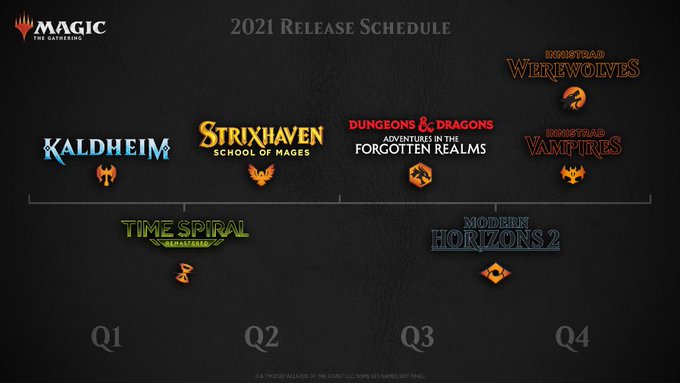
4. Of the 2021 Release Schedule for Magic, you’re most excited to return to Innistrad.
Michael Majors: Fiction. This is a pretty extreme bias, but I co-led the development of Modern Horizons 2 (and as with the first, was involved heavily throughout the set’s process) and I can’t wait to see it in print. I get the apprehension from some of the more hardcore Modern players and their concerns given some of the outliers that were present in the first Modern Horizons, but for a multitude of reasons I’m very proud of that set. Similarly, I’m very proud of my former co-workers and my work on Modern Horizons 2 and can’t wait to see the reaction of folks to it starting in preview season next year.
Ari Lax: Fiction. I have no idea what to think about a double set release, besides wondering which sub-set has Growlithe and which has Vulpix, and there’s a lot of room to disappoint after the masterpiece that was Shadows over Innistrad and Eldritch Moon. I’m here for Innistrad version three, but it’s a moderated “that’s cool” kind of being there for it.
On the other hand, I expect Dungeons and Dragons: Aventures in the Forgotten Realms to be nothing short of amazing. Much like the original Innistrad there’s a trove of lore to dive into and freely interpret into a set, and the best thing is all the foremost experts on making things resonant and flavorful for that universe are probably in the building to work on it.
Plus, to dive into some deep Magic history, I think WotC learned their lesson about dice rolling in Magic testing and abandoning the “hedronize” mechanic’s eight-sided die nonsense for Battle for Zendikar. I really don’t want to have to define and bring regulation d20s for the next paper tournament I play.
Paulo Vitor Damo da Rosa: Fiction. In fact, I would argue that it’s the release I’m least excited for of the regular sets. Don’t get me wrong, I love Innistrad and I’m thrilled to return there, and I also like the Twilight dynamic we seem to have going on with Werewolves VS Vampires, but I’m just that excited for the other sets, as they all hit tropes that I’m a huge fan of. Seriously, look at what we have coming up!
First, there’s Kaldheim. Vikings felt like they were a long time coming and Norse mythology is incredible (I assume / hope there’ll be Norse mythology in Kaldheim).
Then there’s Strixhaven: School of Magic. Harry Potter is my favorite book series so I don’t have to tell you how excited I am for a School of Magic set.
Finally, there’s Dungeons and Dragons: Aventures in the Forgotten Realms. I’ve never been much of a D&D player, but I’ve been a huge D&D fan forever; in fact, my parents bought me the D&D game before I even started playing Magic. (I was really young and they had no idea what this game even was, but they knew I was a nerd who liked Dragons and they were right. Obviously I barely understood half the rules.) I’m the kind of person who will read the Monster Manual for fun without ever intending to play the games and I frequently find myself in Wikipedia rabbit holes where I start reading about some random D&D world or deity or concept and then just spend hours following link after link.
I’ve also read many novels set in D&D worlds (the whole Dragonlance saga is one of my favorites), and I’ve played many games that were set in what world as well (such as Baldur’s Gate I and II, two of my favorite games ever that happen to be set in the same Forgotten Realms world we’re going to see). I know that we’re not going to get a Dumbledore or Hermione card in the School of Magic World, but Magic and D&D are owned by the same company, so we might actually see Elminster, Drizzt, Khelben, Mystra, Lorlach, and all the characters I’ve read so much about. We might actually see Drow characters and Wish spells and famous artifacts like the Book of Vile Darkness. It’s the kind of stuff that you’ve always seen for fun (“hey look, let’s make Magic cards of our favorite characters”) and now it’s actually going to be official!
So, yeah, I’m probably the most excited for this next stretch of sets than I’ve ever been for any year of Magic before, lore-wise. Innistrad is a great plane and in some years going back there might have been my favorite world, but this year it doesn’t stand a chance.
5. The Pathways are the most powerful two-color lands since the Kaladesh fastlands.
Michael Majors: Fiction. Pathways aren’t as strong as shocklands, nor are fastlands as strong as shocklands. That said, Pathways are extremely strong but they are pretty tricky and I suspect will result in some initial growing pains in deckbuilding. It’s underappreciated how having a critical mass of multicolor lands in an environment supports playing color-intensive cards. While Pathways aren’t sacrificing in speed, they do require a careful eye towards the pips that you’re playing. Simply, if you’re splitting evenly in two colored requirements, it’ll be especially difficult to cast CC cards.
Ari Lax: Fiction. I think they’re the best newly printed lands, honestly better than the Kaladesh fastlands in a number of ways, but I think the Ravnica shockland reprints remain the champions over that time frame. Basic land types are just a huge upside even if you don’t consider fetchlands within the bounds of reasonable and the drawback is often negligible.
I think, all-time, the Pathways are going to fall into that top tier of Modern multicolor lands, though. They are somewhere in the range of Horizon lands and Worldwake creature-lands, and ahead of painlands. I think the part I like about them is that they are good in a simple way. They are just lands; they aren’t good because of things outside of being lands.
Well, kinda. I’m just waiting for the Boil Merfolk deck to roll up with all painless blue mana that isn’t Islands. Who needs the second Minamo, School at Water’s Edge when you can just play random blue Pathaways?
Paulo Vitor Damo da Rosa: Fiction. I think the Pathways are very strong cards, very interesting designs and will see plenty of Standard play, but I don’t think they are as strong as the shocklands. Only adding one color of mana is a real cost; I’ve run into issues many times with Fabled Passage where I really want one color of mana right now but know that two turns from now I will need a different color, and then I have to choose.
I also think some control decks would prefer Temples over the Pathways, though that’s obviously a function of how many other tapped lands exist in a given format; the more tapped lands that exist, the better the Pathways are in comparison to other lands that enter the battlefield tapped. Right now, for example, we are overflowed with lands that enter the battlefield tapped because of the Triomes and Fabled Passage, so I think the Pathways are significantly better than Temples for this moment in time, but still not better than shocklands for the most part.
If we discount the Temples and shocklands, since they are reprints, then I guess the only competitors are the Shadows over Innistrad lands such as Port Town and the Amonkhet cycling Deserts such as Irrigated Farmland. I think the Pathways are better than these two lands for the most part (certainly better than Amonkhet cycling Deserts for aggressive decks), so if the question were “The Pathways are the most powerful new two-color lands designs since the Kaladesh fastlands,” I think the answer would have been “fact,” though that would also depend on the context of each format.

